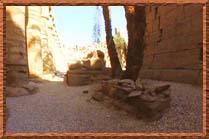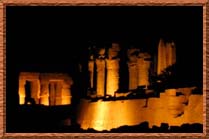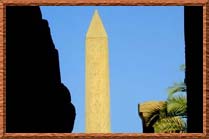|
Thebes of the Hundred Gates
Karnak,
located in the northern part of the modern-day city of Luxor,
the old capital of Thebes, houses a vast complex of temple-domains,
temples, chapels and shrines. The temple-domain of the war-god
Montu is located in the north. The central domain, itself
home to a vast multitude of temples and chapels, was dedicated
to Amun, the king of the gods. The temple-domain to the south
was built for the goddess Mut, Amun's divine consort.
Being
dedicated to the king of the gods, it is not surprising that
the central domain is the largest. The oldest known parts
of this complex date as far back as the early 12th Dynasty
(1991 - 1783 BC) or perhaps even earlier. Only a small but
magnificent chapel, which can now be visited in the Open Air
Museum at Karnak, and some blocks and statues, are all that
remain of the oldest parts of the temple.
The
greatest extension to the temple of Amun occurred during the
New Kingdom (1540 - 1070 BC), more specifically during the
18th and 19th Dynasties. Several kings extended the original
12th Dynasty temple, gradually replacing it with newer and
even more magnificent structures. Generation after generation
contributed to the size and wealth of the temple, adding new
pylons, courts, halls and even chapels.
New
temples were erected within the enclosure walls of the domain
of Amun. To the south, Ramesses III of the 20th Dynasty (1196
- 1070 BC) started with a temple dedicated to the lunar god
Khonsu, son of Amun. To the east, Thutmosis III of the 18th
Dynasty (1540 - 1307) erected a temple dedicated to Amun-Re
as the rising sun. To the north, the small temple of Ptah
was started, only to be completed during the Greek-Roman Period,
more than a thousand years later-
The
building activity at Karnak in general, and at the domain
of Amun in particular, continued until the Greek-Roman era
(332 BC - 396 AD), the last stage of the Ancient Egyptian
civilisation. The many gates in the mud-brick enclosure walls
surrounding the three domains earned Thebes, the ancient capital
of the New Kingdom, its epithet "Thebes of the Hundred Gates".
Several gates were built during the 30th Dynasty (380 - 343
BC) and decorated during the early Ptolemaic era (304 - 30
BC). The gate that gives access to the temple of Khonsu in
the southwestern corner of the domain of Amun is a fine example
of temple decoration during that era.
 |
The
cults at the Karnak temples continued well into the Roman
era (30 BC - 396 AD), but gradually, Christianity would replace
the old religion. With the decay of the old cults and the
diminished importance of Thebes during the Roman era, the
old temples were abandoned. Parts of the Amun temple were
converted into a Christian church. Early Christians, considering
the old religion as demonical, broke the reliefs, demolished
statues and tore down the monumental walls and columns. After
centuries of intense building activity and cult, the temples
at Karnak suffered the same fate as the other Pharaonic buildings
throughout the country. Claimed by the sands of the progressing
desert, they fell into ruin.
The
Temple of Amun Re at Karnak
The
access path leading to the entrance of the temple of Amun
Re is flanked by a row of ram-headed sphinxes on each side.
These formidable statues that combine the ram, one of the
animals symbolising Amun-Re, with the lion, represent Amun-Re
as a powerful deity, guarding the access to his temple. The
sphinxes date to the reign of Ramesses II (1290-1224 BC) of
the 19th Dynasty, although some archaeologists believe that
they may even be older and date to the reign of Amenhotep
III (1391-1353 BC).
Two
high trapezoid towers, together with the gate between them
make up the 1st Pylon that forms the actual entrance to the
temple. In the view of a temple being a symbol of creation,
the pylon represents the edge of the world, the horizon separating
non-creation (the outside) from creation (the temple). The
building of the 1st Pylon was part of one of the last great
building projects on the site, during the 30th Dynasty (380-343
BC). In fact, the northernmost tower was never completed and
left significantly lower than the southern tower. Four vertical
grooves in each tower indicate where gigantic flagpoles once
stood. So huge were these poles that they had to be supported
by massive beams extending from the towers.
Two
huge wooden doors that were only opened on very special occasions
and during festivities once blocked the entrance to the temple.
The
Open Court
·
Having passed the 1st Pylon, the visitor enters a wide Open
Court that symbolises the land. The columns along the northern
and western walls stand for the vegetation that usually grows
on the edge of the land. The ram-headed sphinxes between the
columns once continued the two rows of sphinxes in front of
the 1st Pylon. However, they were moved aside to make place
for other constructions. The small chapel immediately to the
left of the entrance, behind the unfinished northern tower
of the 1st Pylon, was built by Seti II (1214-1204 BC) of the
19th Dynasty as a resting-place for the barks of the Theban
triad that were carried around during some festivals. It has
three entrances, one for each bark. The doorway in the middle
opens onto a long narrow chamber. It is the largest of the
three and was used for the bark of Amun-Re.
 |
The
two other doorways open onto similar but smaller chambers
and were used for the barks of Mut, the wife of Amun-Re, and
Khonsu, their son. To the right of the entrance onto the Open
Court, behind the southern tower of the 1st Pylon, a mudbrick
construction that was once used as scaffolding, hints at the
way the Ancient Egyptians managed to build and later decorate
such gigantic constructions. The southern wall of the Open
Court is interrupted by a small temple, constructed during
the reign of Ramesses III (1194-1163 BC) of the 20th Dynasty.
Its pylon only sports one trapezoid tower, which is quite
exceptional. The temple was also used as a resting-place for
the three divine barks during festivals. It has a pylon, an
open court of its own, a columned hall and a sanctuary consisting
of three chambers, one for each bark.
A
lone column standing almost in the center of the Open Court
was part of a structure built during the reign of Taharqa
(690-664 BC) of the 25th Dynasty. It was used in the annual
ceremony during which the statue of Amun-Re was exposed to
the sun so that it could be charged with solar light. Because
of this specific function, this structure did not have a roof.
Centuries before, a statue representing Ramesses II (1290-1224
BC) or Amenhotep III (1391-1353 BC) had already been erected.
It bears witness to the highly skilled craftsmenship of the
Ancient Egyptian sculptors.
|

|
- The
second pylon separates the Open Court from the Great Hypostyle
Hall, one of Egypt's most impressive architectural achievements.
134 columns tower meters high along the temple's main west-east
axis. The 12 columns that flank the axis are some 10 meters
higher than those in the two aisles. The two easternmost
of these immense columns are part of the vestibule of the
third pylon, built by Amenhotep III (1391 - 1353 BC). This,
along with a parallel construction in the temple of Luxor
dated to the same reign, has led researchers to believe
that Amenhotep III built the 12 central columns. It may
even have been his intention that they would form a narrow
but high columned entry-passage to the temple's inner sanctum.
- The
columns in the two adjourning aisles are some 13 meters
high. They were built and decorated during the reigns of
Seti I (1306 - 1290 BC) and Ramesses II (1290 - 1224 BC).
The royal cartouches of Ramesses are prominent here. Some
of the original colours have been preserved on the massive
stone beams between the tops of the columns. With their
capitals shaped as open papyrus plants (central columns)
and closed lotus flowers (aisles), the Hypostyle Hall symbolises
a huge marshland, a forest made up of Egypt's heraldic plants.
The Hypostyle Hall thus not only represents the marshes
it is also symbolic for Upper and Lower Egypt.
- The
walls of the Great Hypostyle Hall were, like most other
walls, covered with representations of Amun, the principal
deity of the temple, sometimes accompanied by his wife Mut
and their son Khonsu. The kings are often shown presenting
offerings or performing rituals for the gods. Large hieroglyphs
identify the kings and perpetuate their rituals. Very common
themes represented on the outside walls are hunting and
war scenes, showing the victorious king hunting down and
destroying the forces that oppose the forces of creation.
At first sight, the area to the north of the Hypostyle Hall
offers a desolate view. Several semi-erected columns hint
at the existence of smaller structures - chapels dating
to different eras. A path leading north passes some chapels
of the 25th and 26th Dynasties (664 - 525 BC) and eventually
leads to a small and not often visited temple dedicated
to the Memphite god Ptah.
- The
temple of Amun-Re has a double axis. The main axis extends
from the east (sanctuary) to the west (1st Pylon). The secondary
axis runs from north (7th Pylon) to south (10th Pylon) and
connects the temple of Amun-Re with the temple of his divine
wife, Mut and with his second temple at Luxor. The secondary
axis intersects with the primary at the small open court
between the 3rd and 4th Pylons. Before the construction
of the 3rd Pylon during the reign of Amenhotep III (1391-1353
BC) and the Great Hypostyle Hall to the west, this area
had been the entrance to the temple of Amun Re, and a great
open court. Thutmosis I (1494-1482 BC), his son Thutmosis
II (1482-1479 BC) and daughter Hatshepsut (1473-1458 BC)
all erected a pair of obelisks in this area. Only one obelisk
of Thutmosis I and one of Hatshepsut are still standing.
- From
the main axis, the secondary axis starts with a wide-open
court, delimited by the wall between the 3rd and 4th Pylons
to the north, a wall to the east and west and the 7th Pylon
to the south. During excavation and restoration works, literally
thousands of statues of varying sizes were found buried
in this open court. This has given the court its modern-day
name cour de la cachette (cache court). Some of the statues
have been placed against the northern face of the 7th Pylon.
They represent several kings who, at one time, had contributed
to the construction of the temple of Amun-Re. The statues
are of different types, ranging from the Osiri-form (body
apparently wrapped in a shroud, arms tightly against the
body, with only the head and crowns protruding), to standing
and sitting statues (body normally dressed). Facing back
towards the main axis, the visitor will notice the back
of the 1st Pylon to the west, followed by the Great Hypostyle
Hall and the remaining obelisks of Thutmosis I (1494-1482
BC) and Hatshepsut (1473-1458 BC).
 |
- A
new open court stretches to the south of the 7th Pylon.
It is delimited to the south by the 8th pylon. The decoration
of the south face of this pylon is fairly typical: it displays
the king, in this case Thutmosis III (1479-1425 BC), while
smiting one or more enemies. Although these scenes may sometimes
refer to actual victories won by the Egyptians during wars,
they are often interpreted as being purely symbolic. The
pylon, representing the edge of the creation, was the place
where all forces of non-creation, symbolised by Egypt's
political enemies, had to be defeated. For the same reason,
statues representing the king often guarded pylons. The
king could be represented standing, striding or seated on
a throne. Of the statues that once stood before the 7th
Pylon, only the lower parts of the legs and the feet subsist.
- The
8th Pylon is fairly well preserved, and so is one of the
statues standing to its south. Although this statue bears
the name of Thutmosis III (1479-1425 BC), it has often been
credited to Hatshepsut (1473-1458 BC). Because later generations
did not consider Hatshepsut's reign as an independent reign
but more as a regency or a usurpation, her names were very
often replaced by those of her predecessors or co-regent.
Like the 7th Pylon, the 8th Pylon is also decorated with
reliefs showing the victorious king striking down the enemies
of Egypt. Again, an open court stretches to the south of
this pylon. The 9th Pylon in the south, of which only little
remains, delimits it. To the south of the 9th Pylon, another
open court, with the Festival Temple of Amenhotep II (1427-1401
BC) to the east, and finally the 10th Pylon to the south,
can be found.
|
|